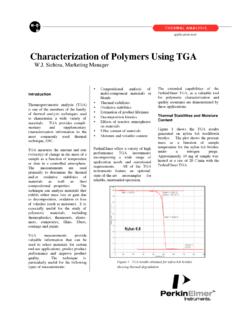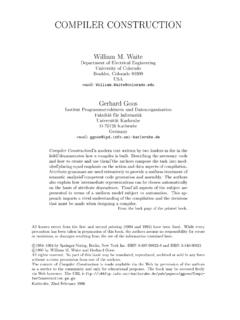Transcription of A Periodic Table of the Elements at Los Alamos National ...
1 A Periodic Table of the Elements at Los Alamos National Laboratory Los Alamos National Laboratory's Chemistry Division Presents Periodic Table of the Elements A Resource for Elementary, Middle School, and High School Students Click an element for more information: Group**. Period 1 18. IA VIIIA. 1A 8A. 1 2 13 14 15 16 17 2. 1 H IIA IIIA IVA VA VIA VIIA He 2A 3A 4A 5A 6A 7A 3 4 5 6 7 8 9 10. 2 Li Be B C N O F Ne 11 12 3 4 5 6 7 13 14 15 16 17 18. 8 9 10 11 12. 3 Na Mg IIIB IVB VB VIB VIIB ------- VIII IB IIB Al Si P S Cl Ar 3B 4B 5B 6B 7B ------- 1B 2B ------- 8 ------- 19 20 21 22 23 24 25 26 27 28 29 30 31 32 33 34 35 36. 4 K Ca Sc Ti V Cr Mn Fe Co Ni Cu Zn Ga Ge As Se Br Kr 37 38 39 40 41 42 43 44 45 46 47 48 49 50 51 52 53 54. 5 Rb Sr Y Zr Nb Mo Tc Ru Rh Pd Ag Cd In Sn Sb Te I Xe (98) 55 56 57 72 73 74 75 76 77 78 79 80 81 82 83 84 85 86. 6 Cs Ba La* Hf Ta W Re Os Ir Pt Au Hg Tl Pb Bi Po At Rn (210) (210) (222).
2 87 88 89 104 105 106 107 108 109 110 111 112 114 116 118. 7 Fr Ra Ac~ Rf Db Sg Bh Hs Mt --- --- --- --- --- --- (223) (226) (227) (257) (260) (263) (262) (265) (266) () () () () () (). (1 of 3) [5/17/2001 4:06:20 PM]. A Periodic Table of the Elements at Los Alamos National Laboratory 58 59 60 61 62 63 64 65 66 67 68 69 70 71. Lanthanide Series* Ce Pr Nd Pm Sm Eu Gd Tb Dy Ho Er Tm Yb Lu (147) 90 91 92 93 94 95 96 97 98 99 100 101 102 103. Actinide Series~ Th Pa U Np Pu Am Cm Bk Cf Es Fm Md No Lr (231) (238) (237) (242) (243) (247) (247) (249) (254) (253) (256) (254) (257). ** Groups are noted by 3 notation conventions. For a list of a the element names and symbols in alphabetical order, click here Download this Web Site to your computer (Adobe Acrobat format - PDF). Get Adobe Acrobat Reader for free Questions - Comments - Feedback Send an email to What is the Periodic Table ? How to use the Periodic Table Click here to see Mendeleev's original Periodic Table Chemistry in a Nutshell Naming New Elements [ LANL | DOE | Disclaimer ].
3 Last Updated: 5/10/2001. (2 of 3) [5/17/2001 4:06:20 PM]. A Periodic Table of the Elements at Los Alamos National Laboratory about this resource (3 of 3) [5/17/2001 4:06:20 PM]. Hydrogen Hydrogen For rocket fuel Atomic Number: 1. Atomic Symbol: H. Atomic Weight: Electron Configuration: 1s1. History (Gr. hydro, water, and genes, forming) Hydrogen was prepared many years before it was recognized as a distinct substance by Cavendish in 1776. Named by Lavoisier, hydrogen is the most abundant of all Elements in the universe. The heavier Elements were originally made from Hydrogen or from other Elements that were originally made from Hydrogen. Sources Hydrogen is estimated to make up more than 90% of all the atoms or three quarters of the mass of the universe. This element is found in the stars, and plays an important part in powering the universe through both the proton-proton reaction and carbon-nitrogen cycle -- stellar hydrogen fusion processes that release massive amounts of energy by combining Hydrogen to form Helium.
4 Production of hydrogen in the alone now amounts to about 3 billion cubic feet per year. Hydrogen is prepared by steam on heated carbon, decomposition of certain hydrocarbons with heat, action of sodium or potassium hydroxide on aluminum electrolysis of water, or displacement from acids by certain metals. Liquid hydrogen is important in cryogenics and in the study of superconductivity, as its melting point is only 20 degrees above absolute zero. Tritium is readily produced in nuclear reactors and is used in the production of the hydrogen bomb. Hydrogen is the primary component of Jupiter and the other gas giant planets. At some depth in the planet's interior the pressure is so great that solid molecular hydrogen is converted to solid metallic (1 of 3) [5/17/2001 4:06:21 PM]. Hydrogen hydrogen. In 1973, a group of Russian experimenters may have produced metallic hydrogen at a pressure of Mbar. At the transition the density changed from to g/cm3.
5 Earlier, in 1972, at Livermore, California, a group also reported on a similar experiment in which they observed a pressure-volume point centered at 2 Mbar. Predictions say that metallic hydrogen may be metastable; others have predicted it would be a superconductor at room temperature. Compounds Although pure Hydrogen is a gas we find very little of it in our atmosphere. Hydrogen gas is so light that uncombined Hydrogen will gain enough velocity from collisions with other gases that they will quickly be ejected from the atmosphere. On earth, hydrogen occurs chiefly in combination with oxygen in water, but it is also present in organic matter such as living plants, petroleum, coal, etc. It is present as the free element in the atmosphere, but only to the extent of less than 1 ppm by volume. The lightest of all gases, hydrogen combines with other Elements -- sometimes explosively -- to form compounds. Uses Great quantities are required commercially for the fixation of nitrogen from the air in the Haber ammonia process and for the hydrogenation of fats and oils.
6 It is also used in large quantities in methanol production, in hydrodealkylation, hydrocracking, and hydrodesulfurization. Other uses include rocket fuel, welding, producing hydrochloric acid, reducing metallic ores, and filling balloons. The lifting power of 1 cubic foot of hydrogen gas is about lb at 0C, 760 mm pressure. The Hydrogen Fuel cell is a developing technology that will allow great amounts of electrical power to be obtained using a source of hyrogen gas. Consideration is being given to an entire economy based on solar- and nuclear-generated hydrogen. Public acceptance, high capital investment, and the high cost of hydrogen with respect to today's fuels are but a few of the problems facing such an economy. Located in remote regions, power plants would electrolyze seawater; the hydrogen produced would travel to distant cities by pipelines. Pollution-free hydrogen could replace natural gas, gasoline, etc.
7 , and could serve as a reducing agent in metallurgy, chemical processing, refining, etc. It could also be used to convert trash into methane and ethylene. Forms Quite apart from isotopes, it has been shown that under ordinary conditions hydrogen gas is a mixture of two kinds of molecules, known as ortho- and para-hydrogen, which differ from one another by the spins of their electrons and nuclei. Normal hydrogen at room temperature contains 25% of the para form and 75% of the ortho form. The ortho form cannot be prepared in the pure state. Since the two forms differ in energy, the physical properties also differ. The melting and boiling points of parahydrogen are about lower than those of normal hydrogen. (2 of 3) [5/17/2001 4:06:21 PM]. Hydrogen Isotopes The ordinary isotope of hydrogen, H, is known as Protium, the other two isotopes are Deuterium (a proton and a neutron) and Tritium (a protron and two neutrons).
8 Hydrogen is the only element whose isotopes have been given different names. Deuterium and Tritium are both used as fuel in nuclear fusion reactors. One atom of Deuterium is found in about 6000 ordinary hydrogen atoms. Deuterium is used as a moderator to slow down neutrons. Tritium atoms are also present but in much smaller proportions. Tritium is readily produced in nuclear reactors and is used in the production of the hydrogen (fusion) bomb. It is also used as a radioactive agent in making luminous paints, and as a tracer. Sources: CRC Handbook of Chemistry and Physics and the American Chemical Society. Last Updated: 12/19/97, CST Information Services Team (3 of 3) [5/17/2001 4:06:21 PM]. Helium Helium For blimps Atomic Number: 2. Atomic Symbol: He Atomic Weight: Electron Configuration: 1s2. History (Gr. helios, the sun). Janssen obtained the first evidence of helium during the solar eclipse of 1868 when he detected a new line in the solar spectrum.
9 Lockyer and Frankland suggested the name helium for the new element. In 1895 Ramsay discovered helium in the uranium mineral clevite while it was independently discovered in cleveite by the Swedish chemists Cleve and Langlet at about the same time. Rutherford and Royds in 1907 demonstrated that alpha particles are helium nuclei. Sources Except for hydrogen, helium is the most abundant element found through out the universe. Helium is extracted from natural gas. In fact, all natural gas contains at least trace quantities of helium. It has been detected spectroscopically in great abundance, especially in the hotter stars, and it is an important component in both the proton-proton reaction and the carbon cycle, which account for the energy of the sun and stars. The fusion of hydrogen into helium provides the energy of the hydrogen bomb. The helium content of the atmosphere is about 1 part in 200,000. While it is present in various radioactive minerals as a decay product, the bulk of the Free World's supply is obtained from wells in Texas, Oklahoma, and Kansas.
10 The only known helium extraction plants, outside the United States, in 1984 were in Eastern Europe (Poland), the USSR, and a few in India. Cost The cost of helium fell from $2500/ft3 in 1915 to cents /ft3 in 1940. The Bureau of Mines has set the price of Grade A helium at $ ft3 in 1986. (1 of 3) [5/17/2001 4:06:22 PM]. Helium Properties Helium has the lowest melting point of any element and is widely used in cryogenic research because its boiling point is close to absolute zero. Also, the element is vital in the study of super conductivity. Using liquid helium, Kurti and co-workers and others, have succeeded in obtaining temperatures of a few microkelvins by the adiabatic demagnetization of copper nuclei. It has other peculiar properties. Helium is the only liquid that cannot be solidified by lowering the temperature. It remains liquid down to absolute zero at ordinary pressures, but it can readily be solidified by increasing the pressure.













